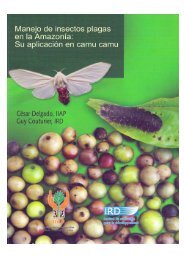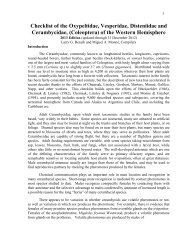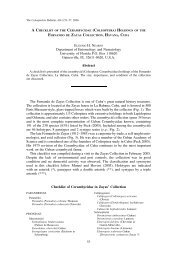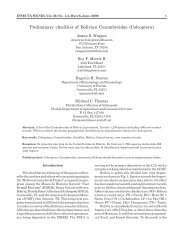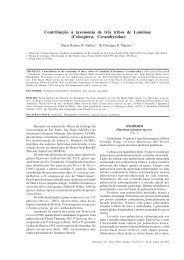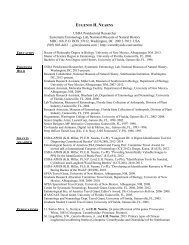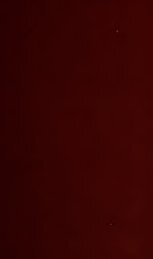You also want an ePaper? Increase the reach of your titles
YUMPU automatically turns print PDFs into web optimized ePapers that Google loves.
34 THE 'l'IHBE ONCIDERTNI<br />
about one-fourth wider than apex; with an apical and basal sulcu3, basal oblique<br />
laterally ; disk with five tubercles, the median from base to middle, elongate, moder<br />
ately elevated, two either side of middle and iust behind apical sulcus, slightly more<br />
elevated than median onc; base with few punctate granules. Scutellum very trans<br />
verse; sides straight, oblique; apex subtruncnte, notched medially. Elytra feebly<br />
attouuate, with sides nearly straight to apices which are separately rounded; at<br />
base either side with a very broad, moderately elevated gibbosity, apical half of the<br />
gibbosities with a row of several very distinct punctate-granules at middle, re<br />
mainder of bnse with coarse, deep, well-spaced punctures, toward apices they<br />
become smaller; humeri prominent, anterior margin arcuate, angle obtusely rounded,<br />
not tuberculate, a short, feebly elevated carina extending posteriorly from humeral<br />
angle. Prosternum not widened behind middle ; mesosternal process notched deeply<br />
at apex; fifth sternite about one-fourth longer than fourth, truncate at apex. Pro<br />
coxae globose, with a short, robust tooth anteriorly; profemora nearly parallel on<br />
basal two-thirds, thence feebly clavate to apex, transversely rugose on dorsal and<br />
ventral sides on basal two-thirds; other femora more suddenly c1avatc; metatibiac<br />
much widened on apical half ; protarsi much dilated. Antennae with seventh<br />
segment attaining elytral apex, remaining segments missing ; scape robust, reach<br />
ing just beyond middle of pronotum, nearly capitate apically, at basal half laterally<br />
with deep grooves, dorsally rugosc, apical portion densely, finely punctate; third<br />
segment moderately slender, sinuate, about onc-si:..1:.h longer than scape; remaining<br />
segments gradually shorter ; scape thinly, third and fourth moderately fimbriate,<br />
slightly so on fifth, sixth, and seventh.<br />
FEMALE. Antennal tubercles very feebly produced ; fifth sternite about two<br />
thirds ngnin as long as fourth, feebly emarginate, broadly triangularly impressed<br />
at apex, either side at apex tufted; procoxae globose, with a feebly elevated, obtme<br />
tubercle; pro£emora gradually clavate, not rugose dorsally and ventrally; metatibiae<br />
less dilated; antennne about as long as body; scape slender, reaching not quite to<br />
middle of pronot-um, very feebly rugose basally, not grooved.<br />
LENGTH 13-14 mm.; width 5.5-6.25 mm.<br />
Holotype.-Male; Cabima, Panama., May 10, 1911 ; (A. Busck) ;<br />
[U.S.N.}.!. number 57221J.<br />
Allotype.-Female ; Rio Frio, Magdalena, Colombia, November<br />
4, 1928; (P. J. Darlington) ; [M.C.Z.].<br />
Hypsioma lyca Dillon and Dillon, spec. nov.<br />
PLATE II, FIGURE 10.<br />
A little larger in form than H. nesiope; elytra with whitish<br />
mottling indistinct and confused, sides not vittate, humeri more<br />
projecting, angle with a large, obtuse tuhercle; antennae with third<br />
segment only a little longer than seape, slightly bisinuate; metafe<br />
mora and metatibiae less distinctly annulate; abdomen medially<br />
thinly gray and brown pubescent, rough in appearance ; antennae<br />
not distietly annulate from fourth segment.


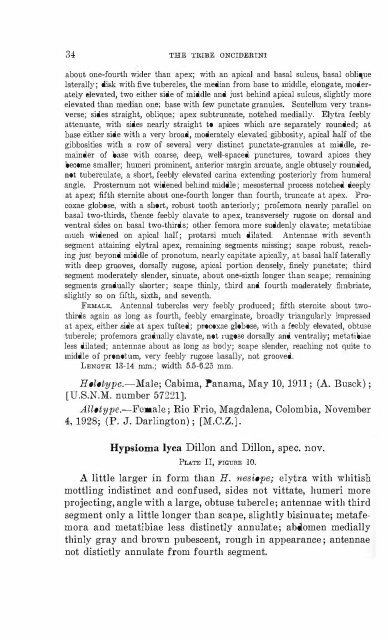
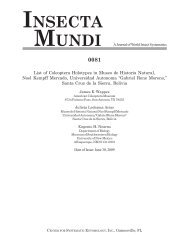
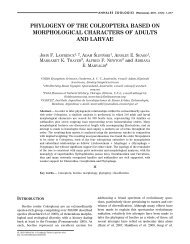


![Coleoptera. Vol. I. [Longicornia. Part I.]](https://img.yumpu.com/41202793/1/180x260/coleoptera-vol-i-longicornia-part-i.jpg?quality=85)
